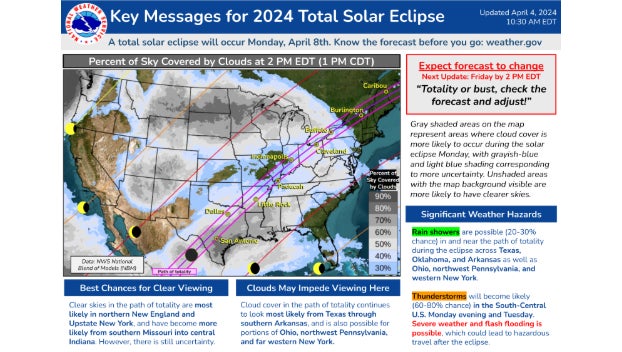Cloudy weather, possible storms may affect the upcoming total solar eclipse.
Published 10:52 am Friday, April 5, 2024
The highly anticipated total solar eclipse is fast approaching, but Mother Nature is throwing a curveball with the weather forecast.
According to the latest reporting from CNN and other national news outlets, the current forecast shows pockets of disruptive cloud coverage in the path of totality and in some areas that are almost the complete opposite of what historical cloud cover data shows for April 8, causing some that made advance plans to scramble to get in position for the best view.
As of Friday, officials with the National Park Service said Vicksburg could expect a 92 percent visibility, the same percentage forecast by eclipse2024.org.
Nationwide, officials say high pressure and a largely cloud-free sky could shape up over the Northeast, especially New England, and create excellent viewing conditions for totality.
Totality, when the moon will entirely block the sun, will occur along a more than 100-mile-wide path from Texas to Maine, passing over cities like Dallas, Indianapolis, Cleveland and Buffalo.
The eclipse will make its journey through the central time zone between 1:30 to 2 p.m.
Meanwhile, a storm system driving a severe weather risk in the Southern Plains and Mississippi Valley could also send moist air from the Gulf of Mexico north into parts of the Tennessee and Ohio valleys. This could potentially lead to an increase in cloud cover in both regions and could obstruct totality views.
A cloudy forecast doesn’t mean one’s eclipse experience will be ruined. Even under a thick, overcast layer of clouds, the eclipse will turn day to night for several minutes in the path of totality.
But for those that can’t see the sun, they also might not be able to watch some special eclipse moments unfold from the ground.
The severe weather risk intersects with a significant portion of the path of totality in the South. Any clouds ahead of the storms could obscure the view for some, but storms are more likely to bring risks for post-eclipse travelers.
Anyone stuck in post-eclipse traffic Monday afternoon or evening in northeastern Texas, southern Oklahoma, southern Arkansas and northern Louisiana could be at risk of damaging thunderstorms.
An estimated 20 million people in the U.S. traveled to another city to view 2017’s total solar eclipse and there was a significant increase in traffic risks as a result, a recent study found.
Millions more are expected to travel for Monday’s eclipse as the path of totality will be 40 to 50 miles wider than 2017’s path.






